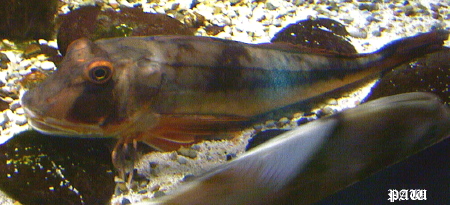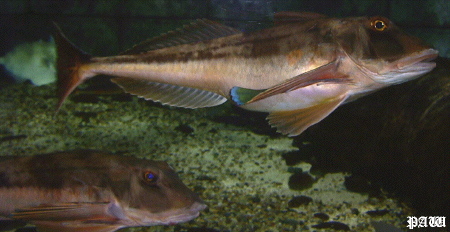Identification:
Large heavy set head with pointed snout. The snout bears two lobes on each side, with small spines at the tips. There is no deep transverse (occipital) groove behind the eyes as seen in some of the other Gurnards. The eyes are relatively small.
Has two dorsal fins. The first is composed of some 8 to 10 membrane bound spines (front edge of first spine is smooth) and has a high profile, whilst the second dorsal fin has a long low profile with 16 to 17 rays and is almost mimicked by the anal fin below with its 14 to 16 rays.
The lower three spines of the pectoral fins are separate, long and thickened (these may be used to "walk" on substrate, or used to locate prey). The pectoral fin reaches back well beyond the vent. The Caudal fin is almost square cut, with a degree of concavity.
The body lacks transverse skin ridges. The scales of the lateral line have no spines, are small and show no appreciable increase in size along its length.
Colouration is a reddish brown on the back and upper sides, blending to reddish pink, with a white to golden belly region.
The inner or upper surface of the pectoral fin is a brilliant almost iridescent bluish green, with blue edge trim.
Breeding:
Spawning from May to July.
Habitat:
Common bottom dwelling fish of inshore waters of between 30 to 150m or deeper, although it may be encountered in the mid-water column. Favours mud to sandy/gravel substrates, with smaller fish found in more shallow waters.
Food:
Favours benthic fauna i.e. crustaceans such as crabs and shrimps, but the diet may also include small fish.
Range:
Found all around the coast of the British Isles.
Additional Notes:
Gurnards are able to grunt or growl by use of muscles associated with the swim bladder, and is believed to aid in keeping schools together. |

